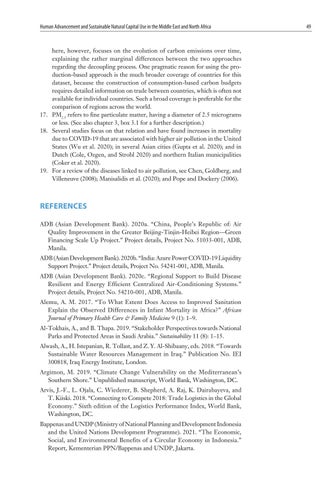Human Advancement and Sustainable Natural Capital Use in the Middle East and North Africa
here, however, focuses on the evolution of carbon emissions over time, explaining the rather marginal differences between the two approaches regarding the decoupling process. One pragmatic reason for using the production-based approach is the much broader coverage of countries for this dataset, because the construction of consumption-based carbon budgets requires detailed information on trade between countries, which is often not available for individual countries. Such a broad coverage is preferable for the comparison of regions across the world. 17. PM2.5 refers to fine particulate matter, having a diameter of 2.5 micrograms or less. (See also chapter 3, box 3.1 for a further description.) 18. Several studies focus on that relation and have found increases in mortality due to COVID-19 that are associated with higher air pollution in the United States (Wu et al. 2020); in several Asian cities (Gupta et al. 2020); and in Dutch (Cole, Ozgen, and Strobl 2020) and northern Italian municipalities (Coker et al. 2020). 19. For a review of the diseases linked to air pollution, see Chen, Goldberg, and Villeneuve (2008); Manisalidis et al. (2020); and Pope and Dockery (2006).
REFERENCES ADB (Asian Development Bank). 2020a. “China, People’s Republic of: Air Quality Improvement in the Greater Beijing-Tinjin-Heibei Region—Green Financing Scale Up Project.” Project details, Project No. 51033-001, ADB, Manila. ADB (Asian Development Bank). 2020b. “India: Azure Power COVID-19 Liquidity Support Project.” Project details, Project No. 54241-001, ADB, Manila. ADB (Asian Development Bank). 2020c. “Regional Support to Build Disease Resilient and Energy Efficient Centralized Air-Conditioning Systems.” Project details, Project No. 54210-001, ADB, Manila. Alemu, A. M. 2017. “To What Extent Does Access to Improved Sanitation Explain the Observed Differences in Infant Mortality in Africa?” African Journal of Primary Health Care & Family Medicine 9 (1): 1–9. Al-Tokhais, A., and B. Thapa. 2019. “Stakeholder Perspectives towards National Parks and Protected Areas in Saudi Arabia.” Sustainability 11 (8): 1–15. Alwash, A., H. Istepanian, R. Tollast, and Z. Y. Al-Shibaany, eds. 2018. “Towards Sustainable Water Resources Management in Iraq.” Publication No. IEI 300818, Iraq Energy Institute, London. Argimon, M. 2019. “Climate Change Vulnerability on the Mediterranean’s Southern Shore.” Unpublished manuscript, World Bank, Washington, DC. Arvis, J.-F., L. Ojala, C. Wiederer, B. Shepherd, A. Raj, K. Dairabayeva, and T. Kiiski. 2018. “Connecting to Compete 2018: Trade Logistics in the Global Economy.” Sixth edition of the Logistics Performance Index, World Bank, Washington, DC. Bappenas and UNDP (Ministry of National Planning and Development Indonesia and the United Nations Development Programme). 2021. “The Economic, Social, and Environmental Benefits of a Circular Economy in Indonesia.” Report, Kementerian PPN/Bappenas and UNDP, Jakarta.
49






